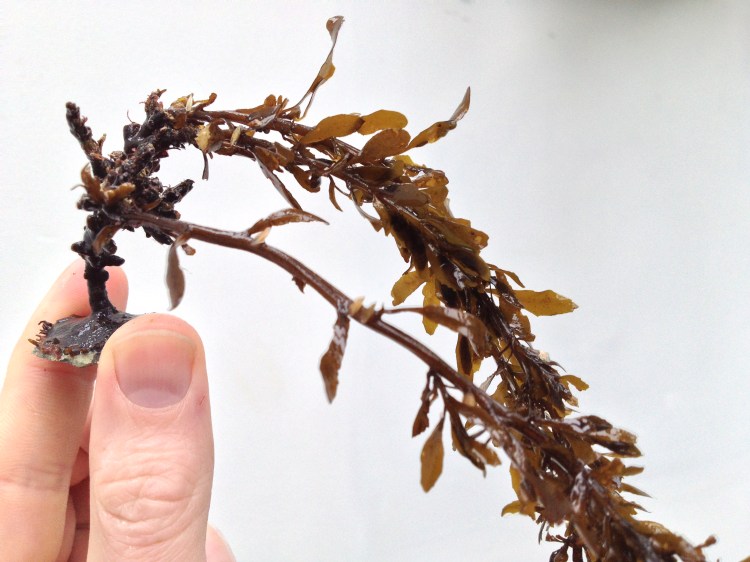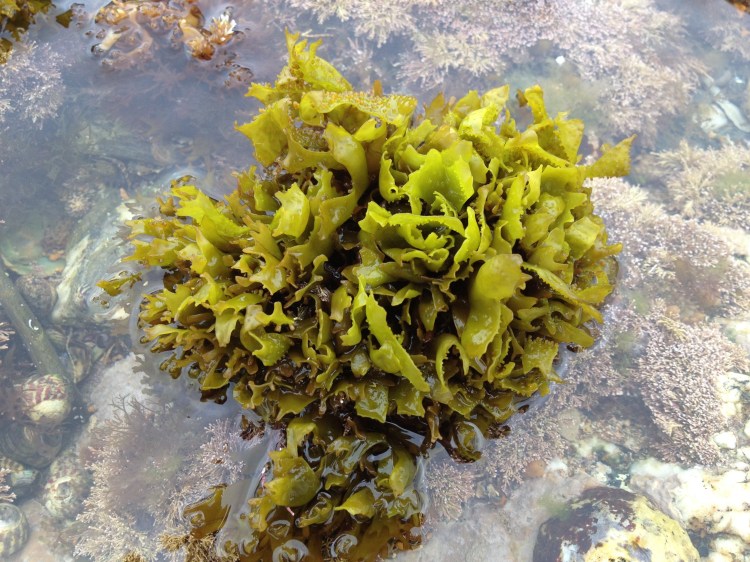After some musing on animals that I had good- (here and here) or bad (here) experiences with during the past year-and-a-bit that I have my aquarium, I thought it would also be good to take stock of my experiences with seaweeds. Not many people have temperate marine aquariums, and only few of those who do seem to focus on seaweeds. That is understandable, because it is hard keeping seaweeds! I currently have almost no seaweeds in my tank, as I wanted a break from the problems I had with die backs and resulting detritus. Below a picture of my 130 liter aquarium at its prettiest (see this post); unfortunately it did not look that way for long (see this post): Although keeping seaweeds in the aquarium is difficult, they are so beautiful, diverse and abundant that it is definitely worthwhile to try. The range of shapes and colors is much greater than that of the vascular plants in freshwater tanks. Also, the fact that so few people seriously try to grow different seaweeds in their tank makes it an extra interesting challenge. My fellow aquarists reading this will agree that it is great to look at a ‘finished’ tank, but building it up and experimenting to ‘get it right’ is an integral part of the fun. Keeping a native tank means that you can collect yourself which is a great activity in itself (and free). being able to observe organisms in their own habitat also gives you some clues on how to best keep them in the aquarium. Anyway, below my personal- and somewhat disjointed thoughts on the topic of keeping seaweeds in the aquarium (with some links to previous posts). Quite a lot to write about so I’ll save some pondering for a part II.
Although keeping seaweeds in the aquarium is difficult, they are so beautiful, diverse and abundant that it is definitely worthwhile to try. The range of shapes and colors is much greater than that of the vascular plants in freshwater tanks. Also, the fact that so few people seriously try to grow different seaweeds in their tank makes it an extra interesting challenge. My fellow aquarists reading this will agree that it is great to look at a ‘finished’ tank, but building it up and experimenting to ‘get it right’ is an integral part of the fun. Keeping a native tank means that you can collect yourself which is a great activity in itself (and free). being able to observe organisms in their own habitat also gives you some clues on how to best keep them in the aquarium. Anyway, below my personal- and somewhat disjointed thoughts on the topic of keeping seaweeds in the aquarium (with some links to previous posts). Quite a lot to write about so I’ll save some pondering for a part II.
1. Many Seaweeds are seasonal
Coming back to the same rock pools over the course of the year, it is very striking to see the composition of seaweed species change. Some species are annuals and always there (although sometimes somewhat overgrown and smaller), but many species are only abundant for a season or even less than that. For example, Dumont’s tubular weed Dumontia contorta was abundant only in early spring this year, whereas Codium tomentosum has just appeared now and will disappear come spring. This must be due to adaptation to annual variations in temperature and daylight (and competition with other species that are present in different months). Although light and temperature conditions can be kept constant in the aquarium, seaweeds are likely ‘programmed’ to thrive at specific times of the year. So in contrast to fresh water planted aquariums where plants just grow and need occasional trimming but otherwise stay the same, marine planted tanks never stay the same. A good example of how a tank can change over time is the series of monthly pictures taken by Jon Olav of his Norwegian native aquarium. I guess for some people, the unpredictability of seaweeds is a downside, not an upside.
2. ‘Planting’ Seaweeds is difficult
The above picture is of Grape pip weed Mastocarpus stellatus. Like many seaweeds, it is very firmly attached to the rocks. Ripping it off results in a handful of separate fronds which will just float around when transferred to the aquarium. Such species (see here for another example) can only be brought over to the aquarium attached to a rock. Some species readily grow on smaller rocks (Solier’s red string weed often is washed up attached to shells) but others don’t. It is possible with suitably shapedseaweeds to weigh them down using a piece of string and a pebble. (I am not sure about the lead weights used to weigh down plants in freshwater aquariums; on one hand lead is toxic, but on the other hand a layer of lead oxide will form around the weight which prevents leaching. Leaching should be less of a problem in salt water which is slightly alkaline anyway. I’ll stick with pebbles in any case!) Some seaweeds on Castle beach in Falmouth when pulled from the substrate take with it a shard of rock, which makes it easy to anchor them in the aquarium (check):
3. Seaweeds can get eaten
Herbivores, such as snails or prawns can start munching on some seaweeds, especially flat greens and reds seemed vulnerable. Perhaps if you provide enough food, they will leave the seaweeds alone (but you risk overfeeding and the disasters that come with that of course). If you are really into your seaweeds, you could also choose to ditch such critters.

Gorgeous Tank picture! Sure that was a lot of work and keeping it looking good even more but like you say the way to get there and the collection is a big part of the fun. Thanks for sharing all the info! I am trying to find the seaweeds that thrive throughout winter and keep those until the next season starts. Looking forward to part 2,3,4 and 5 of this! 😉
What is the name of the seaweed with the bright blue tips please . Have a lot in my aquarium and it seems to be thriving. I am loving all the information you give out. It’s a great read and very informative. Many thanks
Hi Tony, click on the links in the first paragraph for more posts on this beautiful seaweed (or click on the tag below the header): Bushy rainbow wrack. Please try not to collect much of it, as it is a slow-growing, perennial species. If you are able to keep this species for longer, I’d be very interested to learn what conditions you use! I can wholeheartedly recommend the seasearch seaweedguide (see links page), cheers Mick
Hi I have a question can u put saltwater seaweed in a fresh water tank if u bool it
hey, no, they will just rot and make a big mess!
Hi. Me too have a temperate seawater tank – Mediterranean. Happy to meet others. Nice work of yours! But how exactly do you keep the seaweed alive? What are their needs? Because I’ve also tried some, but didn’t make it to keep them alive…
hey…it is difficult! the best strategy I think is getting rocks in that are seeded with spores: what can grow under the specific conditions of your tank will grow. Just adding seaweeds often results in death and lots of nutrients creating problems!
That’s my observation, too. Although I had a certain success with Halimeda and will try Halophila, too… I thought you had some clues… 😉
I enjoyed your videos on youtube! Never been to Bulgaria (or the Black Sea in general), looks like a great place to visit.
In general it’s a country with rich nature. The Black Sea has – still – a lot of untouched spots. Although it is not as diverse as the Medierranean or the North Sea, due to it’s special ecological conditions, it bursts of life. Most interesting to me is, although it hosts species – both plants and animals – that are also present in the Mediterranean, it has a totally different appearance. It looks like a marine planted aquarium. That’s what I try to display in my videos…
Yes, I think of the anoxic dead zones when hearing the Black Sea but luckily it has a lot of life in it as well. The pipefish video was amazing!
I’m doing a brithish rock pool so found this a help